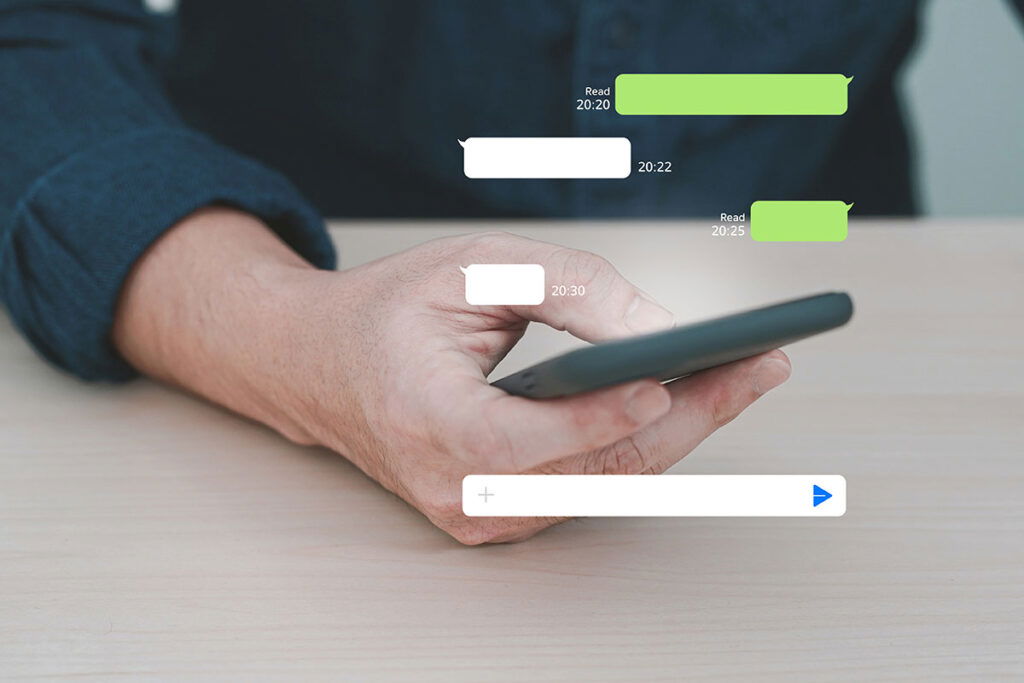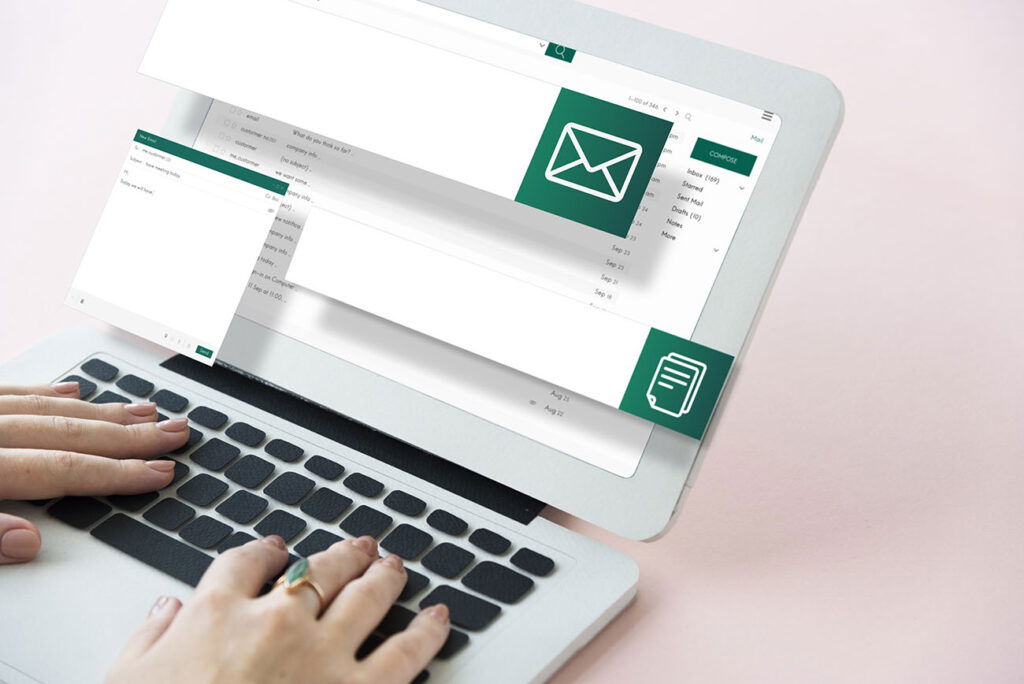Conversational Marketing: What it is & how it works
Table of Contents
What is Conversational Marketing?
If you’re new to the world of marketing, or if you’ve been living under a rock, you’re probably wondering what this Conversational Marketing thing is.
Well, the term first started circulating in late 2017 and has been frequently used in the years since to describe some of the most prominent digital marketing methods and tactics.
As you’d expect from the name, Conversational Marketing is about engaging with your audience at different stages of their journey, starting conversations that maintain and further their interest in your brand, and nudging them towards converting into a new customer.

Where did the term ‘Conversation Marketing’ come from?
The term ‘Conversational Marketing’ was first coined by David Cancel from Drift to put a name on what they were trying to achieve with their business and revolutionise how we talk to our customers.
A lot of businesses, including us, use Drift for their live chat service on their website – you can see it in the bottom right of this screen – and live chats are one of the top examples of a Conversational Marketing channel businesses use today.
The idea that Drift had with Conversational Marketing was to take everything we know about marketing and push it in a different direction.
Rather than that direction being something new and revolutionary, it’s taking us back to a much simpler time when one-on-one communication was at the forefront of every marketing strategy.
With the world of Digital Marketing constantly evolving and countless AI tools and systems being created, some people think we’re moving away from Conversational Marketing and heading for a world of marketing automation.
But your marketing is always going to need that human, personal touch.
That’s why Conversational Marketing is more relevant today than ever.
How to implement Conversational Marketing into your strategy
Using live chat services on your website
As one of the staples of conversational marketing, if you’re not using a live chat function on your website, then you absolutely should be!
The reason they’re so great is they create a direct line of communication between your users and the people within your business.

We use live chats on our website so that if you have any questions about what we do, you can click on the button in the bottom right-hand side of the screen, and you’ll be connected with Adam Tiley, our Commercial Manager, and he’ll respond to your question within a few minutes.
While contact forms essentially serve the same purpose, they don’t have that feeling of human interaction that live chats have. With a contact form, your users submit a message and sometimes have to wait hours, even days, for an email response if you’re busy.
With live chats, the conversations happen in real time and feel more like a back-and-forth conversation.
If you’re using WordPress for your website, there’s a good selection of live chat plugins for you to choose from; as I mentioned earlier in the post, we’ve been using Drift for years now, and it’s brilliant.
You would need someone to monitor this live chat service and respond to messages quickly to connect with the user, but it’s definitely worth looking at if you aren’t already using it!
Writing conversational content
There’s more to conversational marketing than just starting conversations.
You can also focus on improving your content and website copy to sound less stiff and corporate and more like you’re speaking directly to the person reading it.
Conversational content should make your readers feel like you’re talking WITH them — NOT talking AT them. When you engage them in conversation, they should hear your voice through how you write.

If you find it difficult to create conversational content, start by writing a draft and then go back through it with a fine tooth comb, editing it to make it more conversational.
Really critique your writing and ask yourself: “Does this sound like someone talking or someone writing?”
Here are a few tips for making your content more conversational:
Understand your audience: You need to visualise your ideal customer. Are they young? Are they active? Are they adventurous? Are they formal? Whoever your ideal target audience is, you need to write your content in a tone that will entertain and relate to the type of person you want to attract.
Tell stories: You build trust with your audience when you tell stories. They have the power to engage your audience in a way that no other written content can. They’re also far more interesting to read, follow and comment on than boring generic sales copy.
Think about how you can incorporate stories into your online personality. Your online community will always want to hear your stories and get to know you better. The better you know someone, the more likely you are to trust them.
Ask a question: A question changes the flow of your writing by forcing the reader to stop and think, allowing you to follow up your own question with an answer. You can do this at any point in your writing where you feel it fits (there’s a good example in the next tip).
You can also try a series of questions to emphasise a point; they keep your reader involved in the conversation and make it easier to get your point across when the reader shares your perspective, like a verbal conversation.
Write the way you speak: Focus on using common words and expressions you use in everyday conversation. Would you say to someone, “You must be cognizant of the step”, or “Your house looks resplendent”? (yeah, me neither).
You’d say, “Be careful of that step.” and “Your house looks lovely.”.
If you wouldn’t use the word in a verbal conversation, it’s probably best to leave it out.
Building a brand that sparks conversations
Your brand plays a big part in getting your audience to start conversations.
Let’s face it, if you come across a brand that’s plain and boring, you’re not going to feel like reaching out to them or starting conversations with them, are you? Well, the same goes for your branding.
If it’s boring and doesn’t connect with your audience in a meaningful way, then you can’t expect people to spark up conversations with you and rave about your brand.
So, build a brand that starts the conversations for you.
To do that, you need to create a brand that stands out visually, supports causes that matter to your audience, and uses a consistent and conversational brand tone and personality.
Personalising your email campaigns
If you’re sending out marketing emails, then you absolutely have to personalise them.
Email is one of the world’s most widely used marketing channels, so if your emails come across as dull, basic, and like every other shitty sales email your reader receives, it’ll be deleted faster than I could say ‘personalisation matters’.

But here’s the thing. A lot of people hear ‘personalised emails’ and then immediately go, “Oh, I’ll make sure to say ‘Dear Tom,’ instead of ‘Dear Sir or Madam.’ – that’ll make it more personalised.”
And yes, using the recipient’s name is a crucial step in personalisation, but that’s just the start.
Proper email personalisation isn’t just including the recipient’s first name or company name; it’s about:
- Research your audience’s specific interests, pain points, and desires
- Segmenting your audience based on those factors
- Creating email content for each audience segment and their needs
- Writing in a conversational tone the whole time
So, next time you send a marketing email, think to yourself: does this sound like something I would say in person? Does this email highlight my audience’s key problems/interests/needs? Is there anything else I can add or change to make this more personal?
Organising webinars and online events
If you want to speak directly to your audience and provide value to them, then online events and webinars are a great and pretty simple way to do it.
You can set them up using Zoom, send personalised invites to the right people in your audience via email or social media, and then send the meeting link and password to anyone wanting to attend.
In your sessions, you can speak directly to members of your audience, learn more about their needs and challenges, and offer them some form of value that builds their trust in you.

But don’t just use your webinars as a group discovery call or pitch session. It needs to be a session where you provide value to your audience.
Teach them something new, deliver information that they’ll value, or use it as a way for people to discuss their challenges and work together to find solutions.
We do something similar with our 1-2-1 Growth Workshops.
We invite small business owners to pop into our Fareham HQ for a coffee and a chat, and we help them work out a plan for their marketing and business growth, specifically on how to overcome the challenges affecting their growth.
We don’t actively sell during these workshops because it’s all about helping out and providing value to business owners.
But we often find that they get back in touch a few months later and say they want to come on board for an inbound marketing or website design project.
Why? Because they remember that we helped them when they needed it, they know that our advice has helped them improve their marketing, and they trust our team of specialists.
And that’s what you should be aiming to do if you set up webinars or online events.
Bonus tips for nailing your Conversational Marketing
Segment your audience
Understanding your audience, what drives them, and the topics they’re interested in is super helpful when planning your conversational marketing strategy.
Once you’ve carried out audience research, you can segment your audience based on their motivations, interests, and other factors, and tailor your conversations with each segment.
To segment your audience, you should ask yourself questions like:
- Where does my audience typically live?
- What problems does my audience face?
- What are their values and beliefs?
- Have they purchased anything from me before?
- What online platforms does my audience use?
- What benefits are they looking for in a product?
Answering these questions will help you segment your audience into different categories, based on their needs, location, interest, and the online platforms they use.
For example, let’s say you run a financial advice company; here are two potential audience segments that you could identify through these questions:
Segment 1:
- Business owners between the ages of 35 and 60
- Male and female
- Based in cities like London, Manchester, and Bristol
- Struggling with increased business overheads and managing their business financials
- Looking for a way to simply and efficiently manage their business’ revenue, bills, and tax
- Active on LinkedIn & Facebook
Segment 2:
- People between the ages of 18 – 30
- Male and female
- Nationwide
- Struggling to save with the rising cost of living
- Wanting to save and get on the property ladder
- Active on Instagram and TikTok
Looking at those two segments, they’re two very different audiences, and so the language that you’ll need to use in your conversations with them will also be different.
That’s why segmenting your audience is so important in conversational marketing. It helps you engage and build stronger connections with different people in your audience, by using language that resonates with them.
Choose channels that are relevant to your audience
Creating content that sparks conversations is great, but it won’t do squat if you’re not posting it in the right places.
Your audience uses different platforms in different ways. So, you need to be starting conversations in the right places.
Looking at the example segments I used in the last point, if you tried using TikTok to start conversations with middle-aged business owners who desperately need financial advice and support, you wouldn’t be very successful.
But, if you used LinkedIn to engage with their content, start a few conversations in their comments sections, and then slide into their DMs with a friendly message asking how they’re getting on at the moment, you’ll probably get more responses.
Conduct some research to find out which platforms your users are most active on and the types of content they consume on each platform. Then, you’ll be able to see which platforms will be best for your conversational content, and create a plan for engaging and starting conversations with your audience.
Review user data and optimise your strategy
You can’t know if things are working without analysing your strategy, including user behaviour and engagement.
Understanding how your users interact with conversational elements like your web chat or personalised email campaigns is vital for knowing how to improve them and your results.
Use a human tone and approach
Just be human!
No one really wants to read generic, monotone content or messages from a business entity; they want to talk with a real person who understands their needs and problems, and has something of value to offer.
So, just write how you speak, write with empathy and understanding, and just write like a normal human being!
Be consistent
Don’t use a conversational approach in some areas and then turn into a robot elsewhere. If conversational marketing becomes core to your brand, that’s what your audience will expect. If you start getting inconsistent with your tone, it could cause disengagement from your audience.
So make sure you’re being consistent!
Want to have a chat about improving your conversational marketing?
Just click on the chat button in the bottom right corner of this screen – yep, the little blue one just down there – and send us a message, and you’ll get a response shortly after from our Commercial Manager, Adam Tiley.
If you’d rather have a chat at a more convenient time, click here to book a discovery call with Adam.
